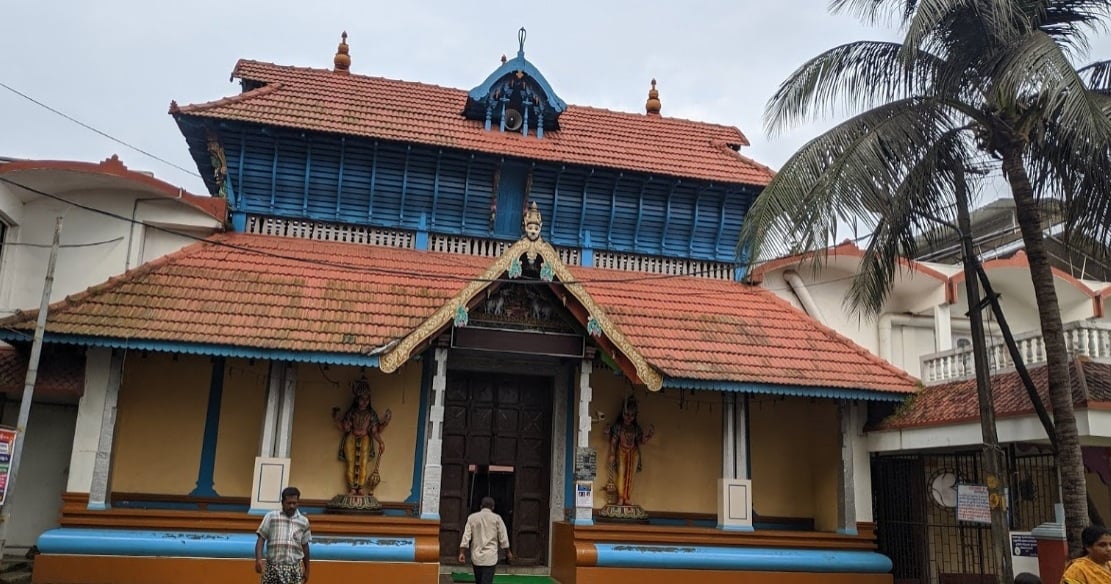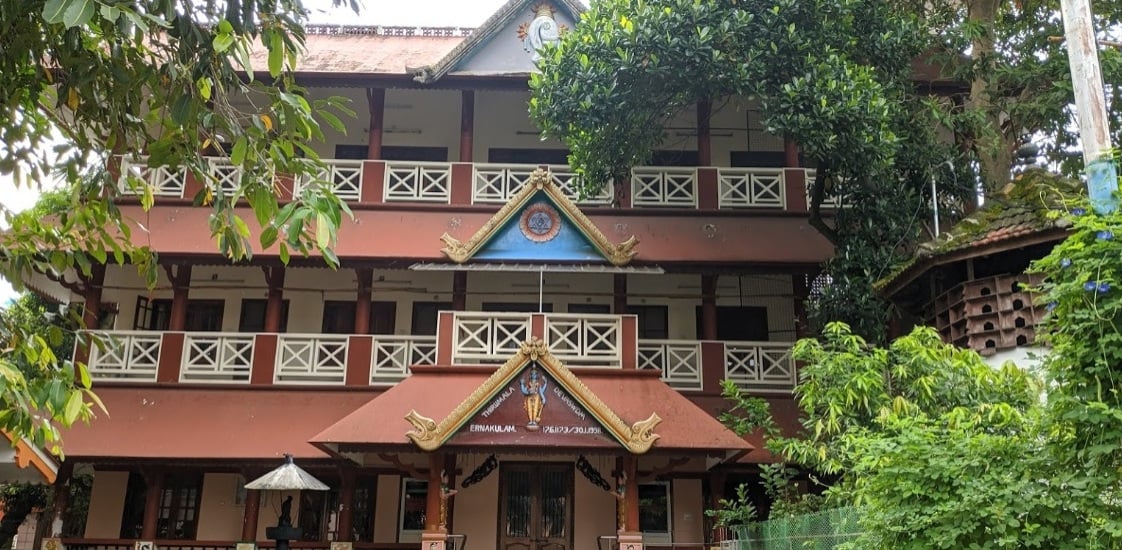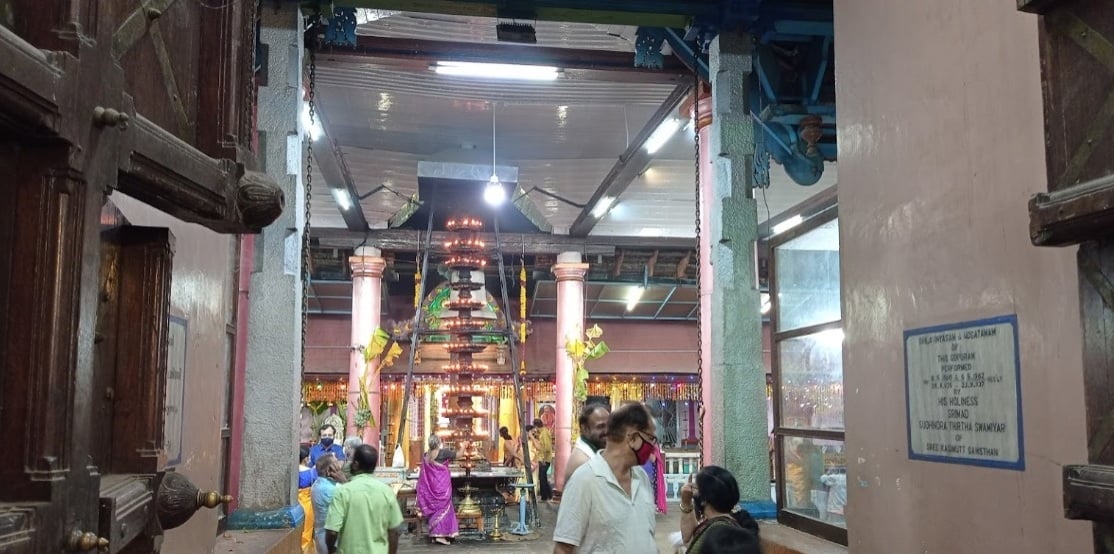Thirumala Devaswom Vishnu Temple, a renowned and ancient temple, is located on T.D. Road, approximately one and a half (1.5) kilometers from the Ernakulam Shenoys Junction.

Gowda Saraswatha Brahmins originally lived along the banks of the mythical Saraswati River, in regions that are now part of Punjab and Rajasthan. When the river dried up around 323 BC, they migrated to Trihotrapura (modern Tirhut in Bihar). Later, Lord Parasurama is believed to have brought ten Rishi families from Trihotrapura to Gomantaka (present-day Goa and parts of Konkan Desh), Panchakrosi, and Kushasthali, settling them there.
This migration gave rise to the Konkani language, named after their new homeland. Due to religious persecution by the Portuguese, the Gowda Saraswathas were forced to leave Goa, abandoning their land, homes, and wealth to preserve their religion, Dharma, and culture. Carrying their Kuladevatas (family deities), they first landed in Calicut but were driven out by the Zamorin. They then traveled southward and settled in various parts of Cochin and Travancore, mainly in coastal areas. Rulers like Vira Kerala Varma provided them refuge and granted them certain rights and privileges, particularly in settlements like Gosripuram.
This migration occurred around 1560 AD, after which they established their own temples.
In the broader classification of Indian Brahmins, they were part of the Gauda group (Panchagowdas), referring to Brahmins who lived north of the Vindhyas, while those in the south were called Dravidas. The Saraswaths, being from the north, prefixed their name with "Gowda." They followed the Venkateswara cult, inspired by the teachings of the great Vaishnava Guru Madhwacharya. As a result, the idol of Lord Venkateswara of Tirumala, Tirupati, is installed in their temples, reflecting their deep-rooted devotion to the deity.
Among the eight families that migrated to Ernakulam, the most prominent was Shri Devaresa Prabhu. Under his leadership, the chief priest, Shri Damodarachari, along with other members of the community, convened a meeting and decided to construct their own temple. In 902 M.E. (1727 AD), Cheranalloor Karta, a ruler and influential landlord, generously donated land for this purpose. The temple’s consecration (Prathishta) took place on the ‘Uthrattathi’ Nakshatra in the month of Mithunam.
Inside the Garbhagriha (Sanctum Sanctorum), Lord Venkatachalapathi is enshrined with His consorts, Sreedevi and Bhudevi, positioned at the top.
At the center, the Uthsava Murthi (festival idol) is placed, while the idol of Shri Mahalakshmi is installed at the bottom. The festival idol and the Bali Vigraha were gifted by the Cochin Thirumala Devaswom (CTD), the main cultural settlement. The Bali Vigraha is placed slightly to the left of the Mahalakshmi idol. Outside the Garbhagriha, in the southwest corner, the idol of Sri Mahaganapathy is installed. In 928 M.E., the prathishta (consecration) of the Hanuman idol, donated by the Mandavana family, was performed in the mandapa facing north. Later, in 1000 M.E., the Kappashery Dasa Shenoy family dedicated an idol of Sri Mahalakshmi, which was consecrated on the northern side of the mandapa, facing south.
Additionally, in 1986, a Garuda temple was constructed at the northwest corner, facing east. The temple underwent renovations, including the construction of agrashalas around it. The second reconsecration (Puna-Prathishta) took place on the Revathi Nakshatra in the month of Makaram, 955 M.E. (1780 A.D). Later, in 1008 M.E., the Dhwaja Prathishta (flagpole installation) was performed, and in 1072 M.E. (1897 A.D), the third Puna-Prathishta Mahotsav was celebrated with great grandeur. This occasion was particularly significant for the community, as Srimad Varadendra Thirtha Swamiji of Sri Kashi Mutt blessed the event.
Maharaja of Cochin also visited the temple for Darshan and offered prayers at the deity's lotus feet. He greatly admired the exquisite wooden carvings that depicted stories from the Ramayana, Mahabharata, and other Puranas. In 1132 M.E. (1957), the 60th anniversary (Shashtiabdapoorthi) of the Puna-Prathishta was commemorated with much devotion. Sahasra Kalashabhishekam was performed in the divine presence of Srimad Sudhindra Thirtha Swamiji of Sri Kashi Mutt. To mark this grand occasion, the Eastern Gopuram was reconstructed in 1137 M.E. (1962). The agrashalas, mandapashalas, and other temple structures were also renovated into a double-storied complex.
On 25th January 1977, the temple’s 250th anniversary was celebrated under the guidance of His Holiness Srimad Sudhindra Thirtha Swamiji. To commemorate this milestone, a magnificent Gopuram was constructed, adorned with intricate statues and aesthetic architectural details, making it a major attraction. In 1989, a Swarna Garuda Vahana was dedicated to Lord Venkatachalapathi to facilitate the Garuda Vahana Pooja, adding further splendor to the temple’s traditions.
തിരുമല ദേവസ്വം വിഷ്ണു ക്ഷേത്രം
എറണാകുളം ഷേണായീസ് ജംഗ്ഷനിൽ നിന്ന് ഏകദേശം ഒന്നര (1.5) കിലോമീറ്റർ അകലെ, T.D. റോഡിൽ സ്ഥിതിചെയ്യുന്ന പ്രസിദ്ധവും പുരാതനവുമായ ക്ഷേത്രമാണ് തിരുമല ദേവസ്വം വിഷ്ണു ക്ഷേത്രം. ഭക്തജനങ്ങളുടെ ആസ്ഥാനമായും ആത്മവിശ്വാസത്തിന്റെ കേന്ദ്രമായും ഈ ക്ഷേത്രം നിലകൊള്ളുന്നു. ഗൗഡ സാരസ്വത് ബ്രാഹ്മണർ (കൊങ്കണി) നിർമ്മിച്ച ഈ ക്ഷേത്രം, അവർക്കായി നിർമിച്ച മഹത്തായ ദേവാലയങ്ങളിൽ ഒന്നാണ്.ഗൗഡ സാരസ്വത് ബ്രാഹ്മണർ ആദ്യം താമസിച്ചിരുന്നത് പുരാണ നദിയായ സരസ്വതിയുടെ തീരത്തായിരുന്നു, ഇത് ഇന്നത്തെ പഞ്ചാബ്, രാജസ്ഥാൻ പ്രദേശങ്ങളിലായി വ്യാപിച്ചിരുന്നതാണ്.
BC 323-ൽ ഈ നദി വറ്റിപ്പോയതിനെ തുടർന്ന്, അവർ ത്രിഹോത്രപുരയിലേക്ക് (ഇന്നത്തെ ബീഹാറിലെ തിർഹട്ട്) കുടിയേറി. അവിടുത്തുനിന്ന്, ഭഗവാൻ പരശുരാമൻ പത്ത് ഋഷി കുടുംബങ്ങളെ ഗോമാന്തക (ഗോവയുടെ പടിഞ്ഞാറൻ മേഖലകൾ), പഞ്ചക്രോസി, കുശസ്തലി എന്നിവിടങ്ങളിലേക്ക് കൊണ്ടുവന്ന് സ്ഥിര താമസത്തിനായി പാർപ്പിച്ചു. അതിനാലാണ് അവരുടെ ഭാഷയ്ക്ക് 'കൊങ്കണി' എന്ന പേര് ലഭിച്ചത്.
പിന്നീട്, പോർച്ചുഗീസ് ഭരണമേറ്റെടുത്തപ്പോൾ മതപീഡനങ്ങൾ രൂക്ഷമായതിനെ തുടർന്ന്, ഗൗഡ സാരസ്വത് ബ്രാഹ്മണർ തങ്ങളുടെ നാട്, ഭവനങ്ങൾ, സമ്പത്ത് എന്നിവ വിട്ട് കേരളത്തിലേക്ക് കുടിയേറേണ്ടിവന്നു. തങ്ങളുടെ മതം, ധർമ്മം, സംസ്കാരം എന്നിവ സംരക്ഷിക്കാനായി, കുലദേവതകളോടൊപ്പം അവർ കോഴിക്കോട്ട് (കാലിക്കട്ട്) എത്തി. എന്നാൽ, സാമൂതിരിയുടെ അതിരുകളിൽ അവർക്കു തങ്ങാനാവാതെ, അവരെ അവിടുനിന്നും പുറത്താക്കി.
തുടർന്ന്, അവർ തെക്കോട്ടേക്ക് സഞ്ചരിച്ച് കൊച്ചി, തിരുവിതാംകൂർ സംസ്ഥാനങ്ങളിലെ (കൂടുതലും തീരപ്രദേശങ്ങളിലായി) വിവിധ ഭാഗങ്ങളിൽ കുടിയേറി.
വീര കേരളവർമ്മ രാജാവിന്റെ നേതൃത്വത്തിൽ, അവർക്കായി ചില പ്രത്യേക സങ്കേതങ്ങൾ (പോലുള്ള ഗോസ്രീപുരം) അനുവദിച്ച്, അവിടത്തെ ഭരണാധികാരികൾ ഇവരെ അഭയവും ആനുകൂല്യങ്ങളും നൽകിക്കൊണ്ടു. പിന്നീട്, ഗൗഡ സാരസ്വത് ബ്രാഹ്മണർ തങ്ങളുടെ വിശ്വാസത്തിനും സംസ്കാരത്തിനും ആധാരമായ നിരവധി ക്ഷേത്രങ്ങൾ കേരളത്തിൽ നിർമ്മിച്ചു. കൊച്ചിയിൽ എത്തിയ എട്ട് കുടുംബങ്ങളിൽ ഏറ്റവും പ്രധാനിയായിരുന്നു പുരോഹിതൻ ശ്രീ. ദേവരേശ പ്രഭു. അന്നത്തെ പ്രമുഖനായിരുന്ന ശ്രീ. ദാമോദരാചാരിയും ഈ സമൂഹവുമായി ചേർന്ന്, ഭക്തിസാന്ദ്രമായ ആരാധനയ്ക്കായി ഒരു ക്ഷേത്രം സ്ഥാപിക്കാൻ തീരുമാനിച്ചു.
902 മാളയാളം വർഷത്തിൽ (1727 എ.ഡി.), ഭരണം നടത്തുന്ന പ്രമുഖ ഭൂമിയുടമയായിരുന്ന ചേരനല്ലൂർ കർത്ത ക്ഷേത്രനിർമ്മാണത്തിനായി ഭൂമി ദാനം ചെയ്തു.
ക്ഷേത്ര പ്രതിഷ്ഠ മിഥുനമാസത്തിലെ 'ഉത്രട്ടാതി' നക്ഷത്ര ദിനത്തിലാണ് നടന്നത്. ഗർഭഗൃഹത്തിൽ (ശ്രീകോവിലിൽ), വെങ്കടാചലപതി ശ്രീദേവിയുടെയും ഭൂദേവിയുടെയും സാന്നിദ്ധ്യത്തോടെ പ്രതിഷ്ഠിക്കപ്പെട്ടു. മഹാലക്ഷ്മിയുടെ വിഗ്രഹം ഗർഭഗൃഹത്തിന്റെ ഇടതുവശത്തായി സ്ഥാപിക്കുകയും, ബാലി വിഗ്രഹം അൽപം അകലെയായി പ്രതിഷ്ഠിക്കപ്പെടുകയും ചെയ്തു. ഹൈന്ദവ താത്വിക സമ്പ്രദായമായ ദ്വൈത സിദ്ധാന്തത്തിന്റെ ആചാര്യനായി വിശേഷിപ്പിക്കപ്പെട്ടിരുന്ന ദേവരേശ പ്രഭു, മഹാ വൈഷ്ണവ ഗുരു മാധവാചാര്യർ പ്രചരിപ്പിച്ച വെങ്കിടേശ്വര ആരാധനാനിര്മിതിയെ പിന്തുടർന്നു.
ഇതിന്റെ ഭാഗമായി തിരുപ്പതിയിലെ വെങ്കിടേശ്വര വിഗ്രഹം അവരുടെ ക്ഷേത്രങ്ങളിലും പ്രതിഷ്ഠയാക്കി.
ക്ഷേത്രത്തിന്റെ തെക്ക്-പടിഞ്ഞാറൻ മൂലയിൽ, ഗർഭഗൃഹത്തിന് പുറത്തായി ശ്രീ മഹാഗണപതി പ്രതിഷ്ഠിക്കപ്പെട്ടു. 928 മാളയാളം വർഷത്തിൽ (1753 എ.ഡി.), മന്ദാവന കുടുംബം സമർപ്പിച്ച ഹനുമാൻ വിഗ്രഹം വടക്ക് അഭിമുഖമായി മണ്ഡപത്തിൽ സ്ഥാപിച്ചു. 1000 മാളയാളം വർഷത്തിൽ (1825 എ.ഡി.), കപ്പശേരി ദാസ ഷേണായി കുടുംബം സമർപ്പിച്ച ശ്രീ മഹാലക്ഷ്മി വിഗ്രഹം, മണ്ഡപത്തിന്റെ വടക്കുവശത്ത് തെക്ക് അഭിമുഖമായി പ്രതിഷ്ഠിക്കപ്പെട്ടു.
1986-ൽ, ക്ഷേത്രത്തിന്റെ വടക്ക്-പടിഞ്ഞാറ് കോണിൽ കിഴക്ക് അഭിമുഖമായി ഒരു ഗരുഡ ക്ഷേത്രം നിർമിച്ചു, ഇത് ക്ഷേത്രഭക്തരുടെ ആസ്തികാനുഭവത്തിൽ പുതുമയും ഭക്തിമുദ്രയും കൂട്ടിച്ചേർത്തു. 955 മാളയാളം വർഷം (1780 എ.ഡി.) ൽ, ക്ഷേത്രം പുതുക്കിപ്പണിയുകയും ക്ഷേത്രത്തിന് ചുറ്റും അഗ്രശാലകൾ നിർമ്മിക്കുകയും ചെയ്തു. മകരമാസത്തിലെ രേവതി നക്ഷത്രദിനത്തിൽ, ക്ഷേത്രം രണ്ടാം തവണയും പുനർനിർമാണം നടത്തി.
1008-ൽ ധ്വജപ്രതിഷ്ഠയും, 1072 മാളയാളം വർഷം (1897 എ.ഡി.) ൽ മൂന്നാമത്തെ പൂന-പ്രതിഷ്ഠ മഹോത്സവും വളരെ ആഡംബരത്തോടെയും ഭക്തിനിർഭരമായ ആഘോഷങ്ങളോടെയും നടത്തപ്പെട്ടു. ശ്രീ കാശി മഠത്തിലെ ശ്രീമദ് വരദേന്ദ്ര തീർത്ഥ സ്വാമിജിയുടെ ദിവ്യ സാന്നിധ്യത്തിലായിരുന്നു ഈ മഹത്തായ ദിവ്യയോഗം. അന്നത്തെ കൊച്ചി മഹാരാജാവ് ദേവന്റെ ദർശനം നടത്തിയെന്നും ഈ മഹോത്സവത്തിൽ പങ്കെടുത്തെന്നും പറയപ്പെടുന്നു.
ME 1132 (1957) ൽ, ഈ പുനഃപ്രതിഷ്ഠയുടെ 60-ാം വാർഷികം (ഷഷ്ട്യബ്ദപൂർത്തി) ഭക്തിസാന്ദ്രമായി ആഘോഷിച്ചു. ശ്രീ ശ്രീമദ് സുധീന്ദ്ര തീർത്ഥ സ്വാമിജിയുടെ ദിവ്യസാന്നിധ്യത്തിൽ സഹസ്രകലശാഭിഷേകം നടത്തി. ഈ മഹത്തായ സന്ദർഭത്തിന്റെ സ്മരണയായി, കിഴക്കേഗോപുരം ME 1137 (1962) ൽ പുനർനിർമിച്ചു. കൂടാതെ, ക്ഷേത്ര പരിസരത്തെ എല്ലാ അഗ്രശാലകളും, മണ്ഡപശാലകളും ഇരുനിലകളായി പുതുക്കിപ്പണിയുകയും ചെയ്തു.
b>Address :
TD West Sannidhi Rd,
Cloth Bazar,
Shenoys,
Kochi,
Ernakulam, Kerala 682035



